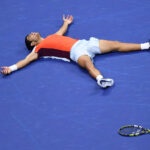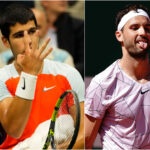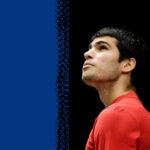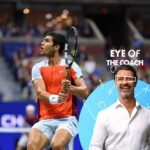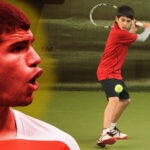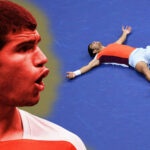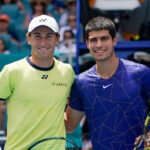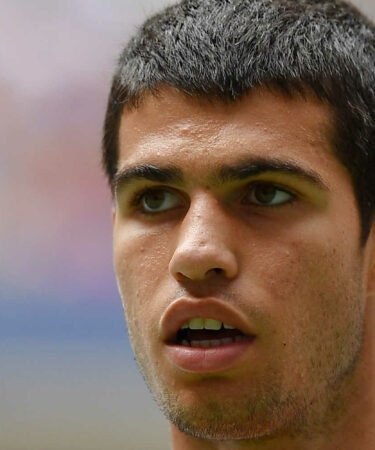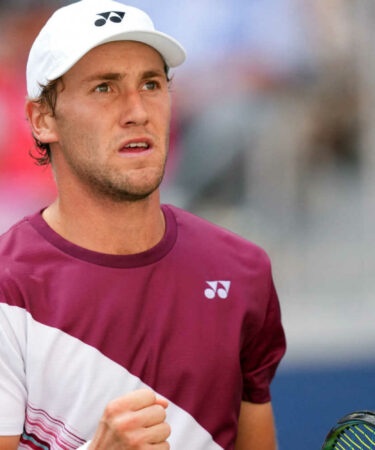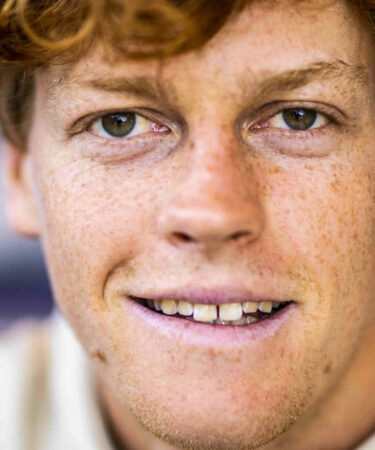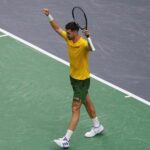From Carlitos to Alcaraz, Episode 3: Attack, defence, power, touch – Alcaraz the pioneer of “total tennis”
Tennis Majors continues its six-part series on the phenomenon of Carlos Alcaraz, the world No 1 after three years of rapid ascension
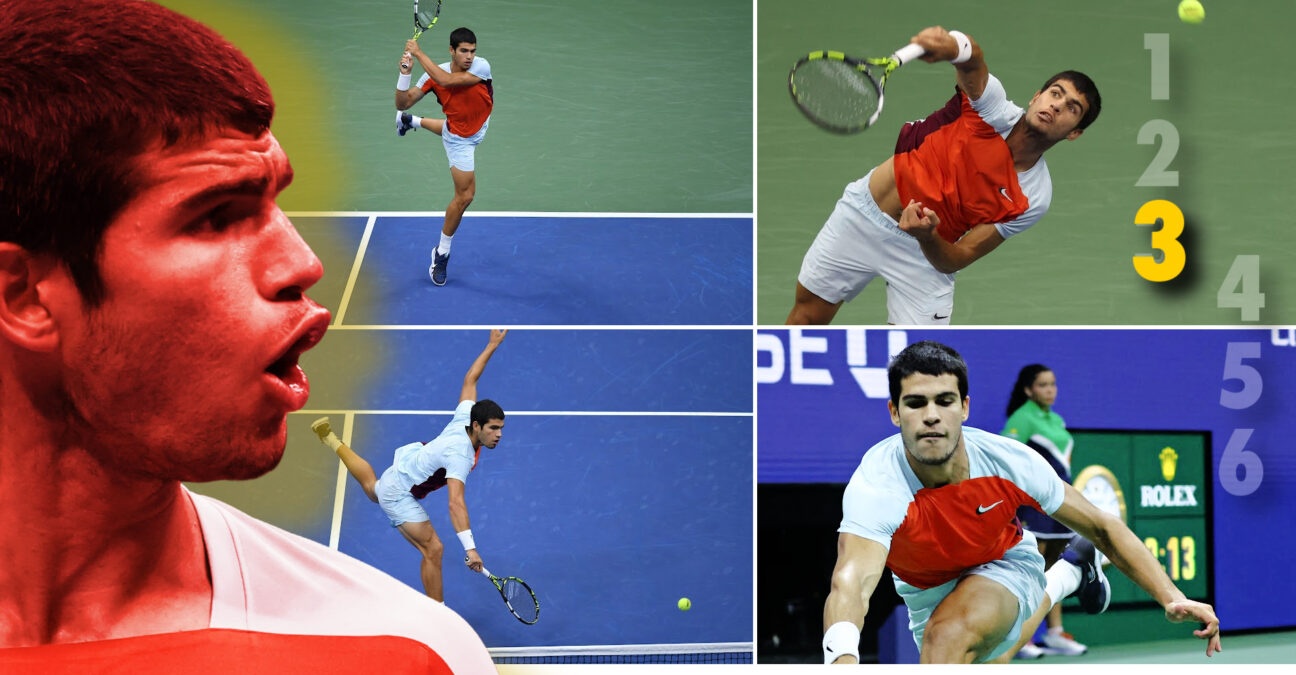 Carlos Alcaraz series by Tennis Majors | © Panoramic / Tennis Majors
Carlos Alcaraz series by Tennis Majors | © Panoramic / Tennis Majors
3/6: In the third episode of our series, we take a closer look at the playing style of Carlos Alcaraz. An unstoppable ball-striker and tireless defender, capable of both prolonging exchanges and cutting them short, Carlos Alcaraz may not be the perfect player, but he is certainly a ‘total’ player.
________________________________________
For as long as anyone can remember, tennis players, to caricature them, have been divided into two categories: attackers and defenders. And then came Carlos Alcaraz, who last month became the youngest ever world No 1 at just 19 years, in the wake of his first Grand Slam title at the US Open, in a style that is both dazzling and chameleonic, capable of winning the craziest rallies as well as shortening them to the extreme.
Sometimes even from one game to another. Even from one point to another. In a word, total tennis. A kind of “ultimate tennis” straight out of a video game.
How do you define Carlos Alcaraz’s style of tennis? When he arrived on the circuit, with his big biceps, his Spanish nationality, his dark look and his racquet sponsor, everyone saw him as the reincarnation of Rafael Nadal.
And then everyone saw that it wasn’t quite the same tennis at the same age. Perhaps also to avoid being burdened with a legacy that is far too heavy, the little Prince of Murcia himself did everything he could to deflect attention by explaining that his game was closer to that of Roger Federer. Which is not so obvious either. So which is it?
“Carlos is always simply Carlos” (Barbier)
“There is no point in comparing, Carlos is simply Carlos: he is both a great striker and a great defender,” replies Marc Barbier, long-time coach of Hugo Gaston, who remains to this day the only French player to have managed to beat the Spanish phenomenon as a professional (last year at the Rolex Paris Masters).
“He is a reflection of everything that can be done in modern tennis. On the one hand, he embodies the Spanish values, with great solidity from the baseline, and on the other, he has a lot of offensive options in his game, with a lot of creativity and a very good hand. He’s the archetypal player who doesn’t really have any limits. At least, technically, he doesn’t.”
The history of tennis is littered with champions who helped change the game. Bill Tilden and his serve. Giuseppe Merlo and his two-handed backhand. Tony Trabert and his covered one-handed backhand. Jimmy Connors and his cadence from the baseline. Björn Borg and his over-the-top lift. Andre Agassi and his early ball striking. And many others.
As for the Big Three, they have synthesised many of these qualities to take tennis into a new era. But without ever really departing, at least in the eyes of the public (and perhaps wrongly), from its founding DNA: Federer the attacker, Nadal the defender, Djokovic the counter-attacker.
The perfect tennis player? Not so fast
Could Carlos Alcaraz be the hidden son of the three-headed Cerberus who dominated world tennis for two decades? Patrick Mouratoglou thinks he’s not far off. “He combines the qualities of the three greatest players of all time,” sums up the founder of the eponymous academy and current coach of Simona Halep and Holger Rune.
“I think the one his game is closest to is Federer. Like him, he’s super aggressive and super creative, always trying to do something with the ball. The speed with which he is able to go from the back to the inside of the court, that’s pure Roger. And at the same time he has the counter-attacking qualities of Djokovic. And he can play long rallies with a lot of spin, like Nadal. To top it off, he serves very well for his size (1.83m), and he returns very well.”
It all sounds like a picture of the perfect player, which of course doesn’t exist in tennis any more than it does in life, otherwise Juan Carlos Ferrero’s nugget wouldn’t keep losing a few matches every now and then.
As we’ve seen again this year, most recently in Astana, the Murcian can still have big “air holes” during a match, which is rather fortunate and reminds us that he’s still a human being, not even 20 years old. But if his body and mind continue to match his ambition, then yes: Carlos Alcaraz will certainly be able to join that prestigious caste of champions who have helped change the game.
I find him much more complete than Rafael Nadal at the same age. That doesn’t mean he’ll have the same record (…) But if everything goes well, for him it’s no-limit.
Marc Barbier (Hugo Gaston’s coach)
“We don’t know how far he will go, but it’s certain that he has the means to change the game, or at least to bring new things to the game,” confirmed Barbier. “I think he is much more complete than Rafael Nadal at the same age. That doesn’t mean that he will have the same record. We don’t know how he will react to success. Maybe after a few Grand Slams he’ll be tired, or injured. But if everything goes well, for him it’s no-limit.”
Nature is well made, and seems to appreciate irony as much as it hates emptiness. Just when we thought we had reached the pinnacle of the sport thanks to the three monsters of the Big Three, here comes a UFO that combines all their qualities. And who has even managed to bring the fans together, since if some are still sceptical about the true brilliance of his future, his style of play, on the other hand, seems to be unanimously accepted, with a few exceptions.

Mike James, video and performance analyst for Mouratoglou Analytics, takes a look at Carlos Alcaraz’s tennis. According to him, the extraordinary – even revolutionary – aspect of his style lies in three essential points:
- His ability to move faster than others in the transition game. “Alcaraz has the ability to go from defence to attack much quicker than previous generations; in the same point, he is able to go from attack to defence and back to attack again if needed,” said the English expert, who believes that this ability, beyond his physical abilities, is above all linked to his state of mind. He said that this ability, beyond his physical abilities, was linked to his mindset. “Traditionally, even if you are a world-class defender like Medvedev or Zverev, you don’t want to go to the net. Alcaraz, if he sniffs half an opportunity to come forward, he’s doing that. You even see him doing serve and volley. You didn’t see Nadal do that before the US Open final 2019, when both of the players ended doing that because they were cancelling each other out from the baseline. Alcaraz is doing it as a choice.”
- Directly linked to the previous point, the “verticality” of his game, i.e. his ability to change his position on the court in a flash and thus confuse his opponent. “The mindset of the best players over the last decade and a half was more: “I stay there, that’s my zone for the match,” said Mike James. “Alcaraz is, for me, the most comfortable to go to the net at this age and finding the best court position in every situation. Also he’s taking drive volleys much earlier, one metre inside the baseline instead of around the service line.
- His innovative use of the drop shot, which we will discuss in more detail when analysing his strokes.

The video analysis expert believes that this “total” tennis, capable of switching in a flash from defence to attack without relying on pre-established patterns of play, is a characteristic that is beginning to be found in many players of the rising generation.
“If we take Jannik Sinner as an example, he takes the ball earlier on both sides than anyone else, and his average hitting speed, again on both sides, is the highest on the circuit,” observes our expert.
“A Holger Rune (who James also works with) is a bit of a mix between the two, with an ability to play extremely fast from point A to point B and to be creative.”
The young players don’t have a particular pattern of play, but a constant desire to create chaos in the opponent’s mind.
Mike James (Mouratoglou analytics)
“These players are reinventing new styles. Being a baseline player, a server-volleyer or something else doesn’t make sense to them. What they want is to surprise in any way they can. They don’t have a particular pattern of play, but a constant desire to create chaos in the opponent’s mind. What we saw at the US Open during the match between Alcaraz and Sinner was ‘video game’ tennis, with the ball travelling at very high speed for five hours.”
With these words, Mike James opened his data box to analyse Carlos Alcaraz’s tennis in more depth, a goldmine based on his last victorious matches at the US Open. Here’s what he came up with, blow by blow:
The Alcaraz serve: can do better
This remains his “least strong” point insofar as he records fewer free points (aces or winning serves) behind his first ball than most of the best, around 20% (compared to 25% to 50% for Nadal or Djokovic and 50% in Medvedev’s best matches).
There is a slight shift in Carlos’ starting position towards the centre of the court (on the deuce court and on the ad side), a sign of his desire to hit wide, which is particularly effective for him.
There is also a big difference in his delivery between the first ball (higher and more forward) and the second ball (lower and more to the left). This makes him perhaps still a bit too predictable, compared to, for example, Federer, who was known for his ability to hit all types of serves with one and the same ball toss.
The return of Alcaraz: hyper aggressive on second serve
What is striking is the difference in his waiting position depending on whether he has to return a first or a second serve from his opponent.
Alcaraz is quite far back on first serves and a good metre forward on second, so as to hit the ball between the hips and shoulders, even if it means making a “jump” return. With an average contact point very close to or even inside the baseline (as in the US Open final against Casper Ruud), which clearly distinguishes him from other players.
Another observation: Alcaraz blocks or slices returns very rarely, even on the opponent’s first serve (17% against Ruud, compared to 54% for the Norwegian in the second week of the US Open). His intention is not only to start the rally, but also to cause pain from the start.
Rallying for Alcaraz: play as soon as possible
Here again, the world No 1 stands out for his ability to hit the ball earlier than his rivals. At the US Open, nearly 30% of his shots were played inside the court, more than all his opponents analysed. This is an undeniable reflection of his offensive tennis. And yet, the statistics also reveal that the longer the rallies, the more effective he is.
At this stage of his career, however, his most prolific channel in terms of percentage of points won remains points of 10 or more shots.
On a technical level, Alcaraz is, along with Ruud, one of the players who puts the most spin on his forehand (3,016 rotations/minute on average against Ruud in the US Open final, compared to 3,214 for the Norwegian). He puts less on his backhand (1969 against the Norwegian’s 2620), a shot that he also uses much less (43% backhand against 37%).
While the forehand remains his best shot by far: for an equivalent ratio of unforced errors, it gives him 50% more points than his opponents, according to the evaluation of the Tennis Profiler website, by statistician Fabrice Sbarro.
The Alcaraz volley: one of the best in the world
Here again, the statistics are clear: among the best players in the world, Carlos Alcaraz is the one who wins the most points at the net. He has a very high success rate there, especially for a player who, like many others, does not come there just to finish the point, but sometimes in bold conditions, with quite a few examples of serve and volley, especially against opponents who tend to return from afar.
When people say that Carlos Alcaraz makes a lot of decisive volleys, it may be a misnomer in the sense that he has another amazing shot: the drive volley. And even more so, according to Mike James, the position from which he is able to play it.
“Agassi was the first to play this type of volley, but he did it from the service box. Then Federer came along and started to hit drive volleys behind the service box. Alcaraz plays them right in front of his baseline. Sometimes when he’s in front of his baseline, ready to attack, instead of waiting for the bounce, he takes another step forward and hits the ball straight up in the air. During the Miami final against Ruud this year, we even saw him do it right after the serve. That’s something we’ve never seen before in this sport.”
The Alcaraz drop shot: Like no one before
It is one of the most famous weapons in his arsenal. It is the subject of what is perhaps the most incredible statistic compiled by Mike James: “Alcaraz wins the point more than 80% of the time when he drops! That’s huge, considering that other elite players are at 52% this season, which is already a good average.”
What stands out about Alcaraz’s drop shot (as well as his drive volley) is the way he uses it. “He sometimes tries it right behind his serve, which nobody did before him, or very rarely,” says Mike James. “Normally, the drop shot is a shot that comes late in the rally, either to finish a well-constructed point or a bit in desperation. He uses it behind his huge kick serve, which is a big tactical change from what we used to see.”
“His game combines incredible power and incredible touch. And I think it’s unheard of at this point. “
Patrick Mouratoglou
Basically, Alcaraz is doing more, earlier and better than anyone else. Where tennis may have reached an extreme in terms of horizontality, he is exploring the confines of verticality.
As we know, finesse is most noticeable when it is opposed to brutality. A drop shot is never as effective as when delivered by a player who is equally capable of delivering huge slaps, putting his opponent on the back foot at all times.
“His game combines incredible power and an incredible touch,” said Patrick Mouratoglou. “Normally, we have one or the other. He has both. And I think it’s unheard of at this point. In the same way that I’ve never seen a 19-year-old player so complete.”
“Never seen before”: it’s what everyone says
“He has something that no one else has: he is absolutely phenomenally light on his feet,” enthused a former French player, Julien Varlet, now a consultant and coach to Constant Lestienne. “Look at him when he moves, he’s always on his toes, always very aerial. That’s what allows him to get into position and reposition himself at breakneck speed. In my opinion, beyond his hand which is of course incredible, that’s where he makes the difference.”
“What I like most about him is his speed of reaction between shots, his ability to hit and immediately follow up with something else. I’ve never seen that before,” adds another former French player (and former DTN), Arnaud Di Pasquale, on Eurosport.
Whatever the praise and whoever the speakers, one observation is often made about Carlos Alcaraz: “never seen before”. A statement that contrasts with the one often heard in recent years of a tennis that is too stereotyped. But the advent of such a phenomenon is not the result of chance either. It is the logical continuation of the history of a sport that has not stopped progressing for 150 years. And yet, at the end of its most glorious era, it is destined to continue doing so.
In reality, according to Mike James, Carlos Alcaraz is above all the logical “product” of this glorious era. The 3.0 version of the Big Three, so to speak. “The young players and their coaches copy what they see on TV. But what we’ve been seeing for years on TV are players who can do wonders in defence like Rafa or play multi-surface tennis like Roger.”
“The young players have been imbued with the reality that today they have to be ready for anything, able to do anything. In fact, we are starting to see other young players on the junior circuit playing this type of total tennis. You can’t claim to be a top player and have a weakness. Those days are over.
No one knows what will become of Carlos Alcaraz’s career, whether he will break all the Grand Slam records or whether he will stop at the one he just won at the US Open. But his game, in any case, seems to foreshadow the tennis of tomorrow (and even today). Those who feared the end of the Federer-Nadal-Djokovic era can rest assured. As always, there will be an “after”. And this “after” promises to be spectacular, especially if you believe Juan Carlos Ferrero, who says that his colt is still only 60% of what he can do…
• All quotes were said to Rémi Bourrières except Patrick Mouratoglou’s and Mike James’ ones, said to Cédric Rouquette

